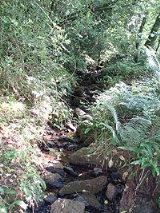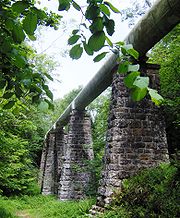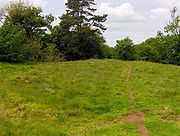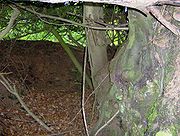
Harptree Combe
Encyclopedia
Harptree Combe is a 13.63 hectares (33.68 acre) Site of Special Scientific Interest
(SSSI) near East Harptree
notified in 1954. "Combe" or "coombe" is a West Country
word meaning a steep-sided valley. It is also the site of a 19th century aqueduct and is overlooked by the site of a castle dating from around 1100.
In August 2009 22.67 acres (9.2 ha) of the Combe were purchased by Alan Sheppard for £60,000. He became the third owner since 1805, the previous sale being in 1922.
Grassy clearings within the combe are the only site in Avon
where the nationally scarce Spreading Bellflower Campanula patula is found. The species was first found here in 1829.
Harptree Combe is a narrow limestone gorge containing a variety of habitats, including Ash woodland, rough grassland, natural and artificial rock faces, and a small, marshy stream. The valley wood has been identified as an ancient woodland site, rich in tree and shrub species, and with a ground flora containing plants such as Herb Paris, (Paris quadrifolia), indicative of such undisturbed habitats. Several other uncommon or local plants, such as Small Teasel
, (Dipsacus pilosus) and Autumn Crocus
, (Colchicum autumnale), also occur. The limestone
rock exposures and aqueduct walls are location for many species of moss
and fern
, some of which, eg Rusty Beard-moss (Didymodon ferrugineus previously known as Barbula reflexa), Brown Beard-moss (Didymodon spadiceus previously known as Barbula spadicea) and Brittle Bladder-fern (Cystopteris fragilis), are rare in Southern England.
 An aqueduct for Bristol
An aqueduct for Bristol
water supply follows the line of the combe. It was completed in 1851, with John Simpson acting as the chief engineer, and it is still in use today. It consists of a wrought iron
tube, which runs underground for 18 km, to Bristol Reservoirs but where it appears above ground it is supported by limestone
piers and abutments. It is probably the oldest surviving example of such engineering and has been designated by English Heritage
as a grade II listed building.
 The scanty ruins, of Richmont Castle are about just above the combe. The castle was besieged in 1138 when King Stephen
The scanty ruins, of Richmont Castle are about just above the combe. The castle was besieged in 1138 when King Stephen
captured it from Sir William de Harptree a supporter of Queen Matilda's
cause in the civil war
between the king and queen. The castle was also visited by King John
in 1205. The castle was demolished by its owner, Sir John Newton, in the reign of Henry VIII
.
 Wade and Wade in their 1929 book "Somerset" described it; "On an inaccessible tongue of land at the far end of the gorge are the remains of Richmont Castle, one of those lawless strongholds which in the days of Stephen were a terror to the country side. In 1138 it was strongly garrisoned by its owner, William de Harptree, on behalf of the Empress Matilda, but was taken by Stephen by the ruse of a feigned repulse. Now, only a fragment of the keep overlooks the glen." Some earthworks are still visible but partially covered by the undergrowth.
Wade and Wade in their 1929 book "Somerset" described it; "On an inaccessible tongue of land at the far end of the gorge are the remains of Richmont Castle, one of those lawless strongholds which in the days of Stephen were a terror to the country side. In 1138 it was strongly garrisoned by its owner, William de Harptree, on behalf of the Empress Matilda, but was taken by Stephen by the ruse of a feigned repulse. Now, only a fragment of the keep overlooks the glen." Some earthworks are still visible but partially covered by the undergrowth.
Site of Special Scientific Interest
A Site of Special Scientific Interest is a conservation designation denoting a protected area in the United Kingdom. SSSIs are the basic building block of site-based nature conservation legislation and most other legal nature/geological conservation designations in Great Britain are based upon...
(SSSI) near East Harptree
East Harptree
East Harptree is a village and civil parish in Somerset, England. It is situated north of Wells and south of Bristol, on the northern slope of the Mendip Hills overlooking the Chew Valley. The parish has a population of 680...
notified in 1954. "Combe" or "coombe" is a West Country
West Country
The West Country is an informal term for the area of south western England roughly corresponding to the modern South West England government region. It is often defined to encompass the historic counties of Cornwall, Devon, Dorset and Somerset and the City of Bristol, while the counties of...
word meaning a steep-sided valley. It is also the site of a 19th century aqueduct and is overlooked by the site of a castle dating from around 1100.
In August 2009 22.67 acres (9.2 ha) of the Combe were purchased by Alan Sheppard for £60,000. He became the third owner since 1805, the previous sale being in 1922.
Ecology
Appleyard's Feather-moss (Brachythecium appleyardiae) was described as new to science from this site in 1981, although doubt has been cast on the validity of the species as a result of genetic evidence published in 2005 which suggests that this moss is in fact a member of the widespread moss species, Scleropodium cespitans.Grassy clearings within the combe are the only site in Avon
Avon (county)
Avon was, from 1974 to 1996, a non-metropolitan and ceremonial county in the west of England.The county was named after the River Avon, which runs through the area. It was formed from parts of the historic counties of Gloucestershire and Somerset, together with the City of Bristol...
where the nationally scarce Spreading Bellflower Campanula patula is found. The species was first found here in 1829.
Harptree Combe is a narrow limestone gorge containing a variety of habitats, including Ash woodland, rough grassland, natural and artificial rock faces, and a small, marshy stream. The valley wood has been identified as an ancient woodland site, rich in tree and shrub species, and with a ground flora containing plants such as Herb Paris, (Paris quadrifolia), indicative of such undisturbed habitats. Several other uncommon or local plants, such as Small Teasel
Dipsacus
Dipsacus is a genus of flowering plant in the family Dipsacaceae. The members of this genus are known as teasel or teazel or teazle. The genus includes about 15 species of tall herbaceous biennial plants growing to tall...
, (Dipsacus pilosus) and Autumn Crocus
Colchicum autumnale
Colchicum autumnale, commonly known as autumn crocus, meadow saffron or naked lady, is a flower which resembles the true crocuses, but flowering in autumn...
, (Colchicum autumnale), also occur. The limestone
Limestone
Limestone is a sedimentary rock composed largely of the minerals calcite and aragonite, which are different crystal forms of calcium carbonate . Many limestones are composed from skeletal fragments of marine organisms such as coral or foraminifera....
rock exposures and aqueduct walls are location for many species of moss
Moss
Mosses are small, soft plants that are typically 1–10 cm tall, though some species are much larger. They commonly grow close together in clumps or mats in damp or shady locations. They do not have flowers or seeds, and their simple leaves cover the thin wiry stems...
and fern
Fern
A fern is any one of a group of about 12,000 species of plants belonging to the botanical group known as Pteridophyta. Unlike mosses, they have xylem and phloem . They have stems, leaves, and roots like other vascular plants...
, some of which, eg Rusty Beard-moss (Didymodon ferrugineus previously known as Barbula reflexa), Brown Beard-moss (Didymodon spadiceus previously known as Barbula spadicea) and Brittle Bladder-fern (Cystopteris fragilis), are rare in Southern England.
Aqueduct

Bristol
Bristol is a city, unitary authority area and ceremonial county in South West England, with an estimated population of 433,100 for the unitary authority in 2009, and a surrounding Larger Urban Zone with an estimated 1,070,000 residents in 2007...
water supply follows the line of the combe. It was completed in 1851, with John Simpson acting as the chief engineer, and it is still in use today. It consists of a wrought iron
Wrought iron
thumb|The [[Eiffel tower]] is constructed from [[puddle iron]], a form of wrought ironWrought iron is an iron alloy with a very low carbon...
tube, which runs underground for 18 km, to Bristol Reservoirs but where it appears above ground it is supported by limestone
Limestone
Limestone is a sedimentary rock composed largely of the minerals calcite and aragonite, which are different crystal forms of calcium carbonate . Many limestones are composed from skeletal fragments of marine organisms such as coral or foraminifera....
piers and abutments. It is probably the oldest surviving example of such engineering and has been designated by English Heritage
English Heritage
English Heritage . is an executive non-departmental public body of the British Government sponsored by the Department for Culture, Media and Sport...
as a grade II listed building.
Richmont Castle

Stephen of England
Stephen , often referred to as Stephen of Blois , was a grandson of William the Conqueror. He was King of England from 1135 to his death, and also the Count of Boulogne by right of his wife. Stephen's reign was marked by the Anarchy, a civil war with his cousin and rival, the Empress Matilda...
captured it from Sir William de Harptree a supporter of Queen Matilda's
Empress Matilda
Empress Matilda , also known as Matilda of England or Maude, was the daughter and heir of King Henry I of England. Matilda and her younger brother, William Adelin, were the only legitimate children of King Henry to survive to adulthood...
cause in the civil war
English Civil War
The English Civil War was a series of armed conflicts and political machinations between Parliamentarians and Royalists...
between the king and queen. The castle was also visited by King John
John of England
John , also known as John Lackland , was King of England from 6 April 1199 until his death...
in 1205. The castle was demolished by its owner, Sir John Newton, in the reign of Henry VIII
Henry VIII of England
Henry VIII was King of England from 21 April 1509 until his death. He was Lord, and later King, of Ireland, as well as continuing the nominal claim by the English monarchs to the Kingdom of France...
.

Further reading
- Thompson, H. Stewart (1916) The vegetation of Harptree Combe Journal of BotanyJournal of Botany, British and ForeignJournal of Botany, British and Foreign is a monthly journal that was edited by Berthold Carl Seemann between 1863–1871....
vol. 54 pp. 295–97

